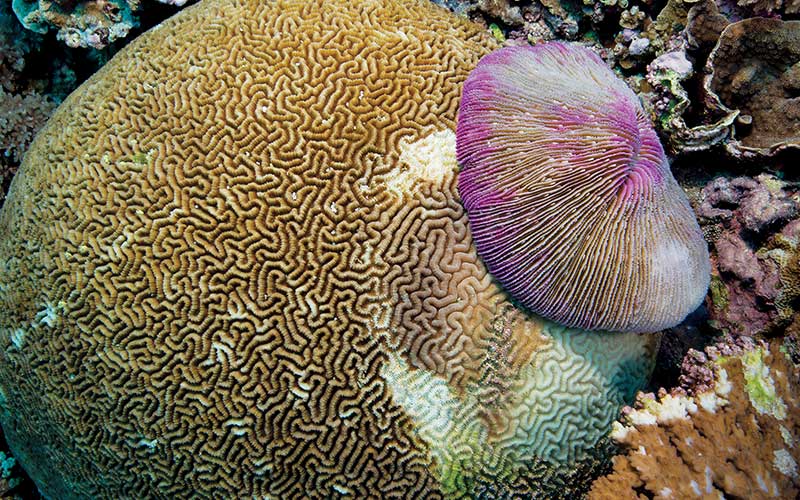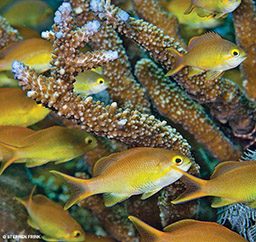Coral Competition
Corals are animals known as anthozoans, literally “flower animals,” but their delicate appearances belie very aggressive attitudes. Corals are not nice. To survive they must defeat competitors that try to occupy the same space. In the absence of zoning laws and property rights it helps to have chemical and biological weapons. For example, corals may extend sweeper tentacles loaded with stinging cells called nematocysts, waving them in the direction of anything they sense nearby. Many corals have a sting so potent it can be felt — and not soon forgotten — by divers, producing painful welts that may require medical attention.
Corals also produce allelopathic substances, letting them waft into the water to suppress the health and happiness of their neighbors. Many soft corals produce terpenoid compounds that not only protect their territory but also make them taste bad to predators. If chemical and biological warfare don’t do the trick, some stony corals may use an even more practical option: Eat and digest thy neighbor. Stringlike digestive filaments cast out from the mouth or directly through the corals’ sides quickly decompose what they touch.
In the several coral species that live unattached, an alternative defensive approach is moving to a new location. Despite having no brain, no eyes and no legs, they somehow sense when things aren’t right; in a coordinated way they inflate and deflate the polyp to literally walk, or they use the currents to move like a sailboat. Such free-living corals may avoid a toxic neighbor, flip themselves upright when turned over, unbury themselves when covered in sediment or pounce on another coral to smother it. Despite all these defenses, corals don’t always win their battles. Some grow faster or are more potent than others, and some sponges and many types of algae have chemical and biological arsenals that can kill corals.

Coral Feeding
When we think of corals feeding, the image of a wall of mouths comes to mind. Coral polyps extend their tentacles to trap plankton from the moving water, but there are other food sources and modes of feeding, too. In places with little water movement corals feed on suspensions of fine particles and larger organic aggregates that fall from upper layers of the water column; this is called marine snow, and corals use hairlike cilia to move the particles into the polyps’ mouths. Coral mucus is referred to as a molecular trap because it captures not only particulate but also dissolved organic material that serves as food for both the coral and its commensal bacteria. Mucus shed into the water also traps food and rains back down onto the corals as nutritious organic particles.
Symbiosis and Feeding
Many corals form a symbiosis with photosynthetic dinoflagellates commonly known as zooxanthellae. They produce food for the corals and receive essential nutrients in return. However, this is more than a simple two-way partnership — it establishes a whole community called a coral biome. Though corals are not nice with some neighbors, it seems they have a powerful capacity to form lasting relationships with other organisms, including bacteria and other microorganisms as well as crustaceans, worms, clams and fish. Reef fish that shelter in corals, for example, supply a nutritious gift in return: feces and dissolved nitrogenous waste. Fish that bite and break apart corals in search of food provide the service of spreading coral fragments.
Asexual “Vegetative” Reproduction

The advice to not touch the corals may prompt you to think about how delicate corals are, but it is far more likely that you would be injured by the contact. I’m not advocating that divers stomp on reefs, but breakage is an important mode of reproduction for corals. The fragments (“frags”) are clones of the parent that can grow into whole colonies. This vegetative reproduction is easily exploited for coral farming.
The Coral Restoration Foundation (CRF) produces coral cuttings from a number of diverse genotypes that they maintain to grow on “trees” in the sea. Fragments quickly grow into large colonies that are further fragmented to grow more colonies. These spawn, and so the farm itself is a significant source of coral larvae with diverse genetic parentages. Anyone who loves corals should support the work of CRF and take the time to join them chopping up corals, hanging them in the farm and transplanting them on reefs.
Aside from “fragging,” asexual reproduction in corals includes the simple process of growth (polyps bud or divide so the colony expands), “polyp bail-out” in which polyps separate from the skeleton and settle in a new location and even the formation of swimming larvae by internal vegetative budding. Perhaps the most amazing feat of coral asexual reproduction is the capacity to be “resurrected.” A dead coral is often not a dead coral. Small bits of tissue — a few cells maybe — can survive deep within the skeleton after an event that seems to have killed the coral. Like seeds, the cells survive there for months and then grow into polyps when conditions are right. The entire coral may regrow over the original skeleton from these vestiges; alternatively they may produce buds called anthocauli that generate baby corals from the original “mother.”

Sex and Reproduction
Corals have sex lives, too. While being sessile limits the range of positions, sex offers a chance to make new genetic combinations, which promotes diversity and vigor. Corals release eggs and sperm into the water, where they combine to form planula larvae. Corals may be male, female or hermaphrodites that release eggs and sperm simultaneously. In some corals only sperm are released into the water while eggs are retained in the polyps. For these corals fertilization is internal, and the larvae are “brooded.”
Since fertilization success between siblings is commonly low, outcrossing with genetically distinct varieties is critical to maintenance and expansion of populations. Even hybridizing is a part of this survival strategy; the synchronized mass broadcast spawning of corals puts together the gametes of many different species and genera in a soup of chance combinations, producing hybrids — much like cross pollination in plants,1 and hybrids are often fertile. New genetic combinations are key to corals’ ability to adapt to changes in their environment.
Corals spawn en masse at the time when water temperature and day length put them at risk for bleaching and heat shock. Why would they spawn at the very time when the survival of their delicate larvae is most at risk? The larvae produced during this time must be fit to survive the heat stress, so the strategy provides a rapid way to adapt to increasing temperatures. Thus there are two benefits to the synchronized spawning occurring at this time: outcrossing, which promotes vigor and variation, and exposure to stressful conditions to select for hardiness.2
Immortal Corals
Poets and philosophers have commented on the fact that the brevity of a flower’s existence makes its beauty more precious. We may feel the same way about corals, but this notion is deceptive. Compared with corals, we are the cut flowers. Corals can live for centuries, and the ability to form clones helps ensure the survival of a genetic “individual” against many types of accidents. A reef that loses 90 percent of its coral cover may not have lost a single individual. Extreme events sometimes kill most or all members of a particular clone or species on a reef, but it is not correct to equate coral cover to coral numbers.

Coral Chimeras
Sometimes an individual coral is not an individual but the product of two or more genetically distinct corals that have fused — a chimera. Corals offer a unique perspective into the process of immune response as they sometimes form chimeras when planula larvae settle next to each other, fuse and grow as one individual. Chimeras may also result from chance fusion between compatible neighbors. They not only don’t fight but may even benefit from genetic exchange.
Coral Fluorescence
Illuminating a coral with blue, green or ultraviolet light produces a fantastic show of color due to the presence of fluorescent proteins. Corals are typically shades of brown, blue or purple with a little green fluorescence, but in some places they have patterns in brilliant fluorescent green, red and orange, the product of mutations in the expression of green fluorescent protein. The purposes of the fluorescent colors are not fully known, but the colors impart charm and attractiveness to the corals, which enhances our appreciation of them. We select, cultivate and thus perpetuate fruit trees and ornamental plants for similar charms.
Corals in Captivity
Corals are now easily grown and propagated, like houseplants, in aquariums all over the world in artificial seawater far from the sea. Is it an exaggeration to say that these corals have migrated inland in advance of a coming sea-level rise? Is it a stretch to imagine that corals love us, too? Or are they just using us, charming us with their beauty, as a way to perpetuate their survival?

References
- Veron JEN. Corals In Space and Time: The Biogeography and Evolution of the Scleractinia (Ithaca, N.Y.: Cornell University Press, 1995.)
- Sprung J. Accidental Selection: How chance plays a role in the survival and evolution of aquatic creatures. Coral, 2011; 8(4): 52-64.
© Alert Diver — Spring 2014